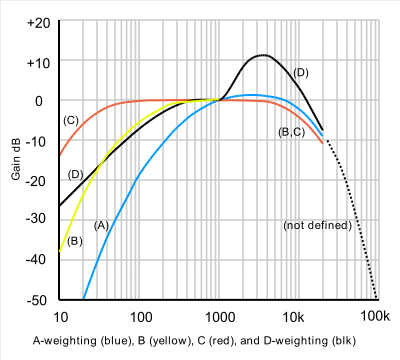
Back A-bewerteta Schoidruckpegl BAR Decibel A Catalan Bewerteter Schalldruckpegel German A-korrektsioon Estonian Décibel A French Pesatura A Italian A特性 Japanese Pesadura A LMO DB(A) Dutch Ниво гласности Serbian

A-weighting is a form of frequency weighting and the most commonly used of a family of curves defined in the International standard IEC 61672:2003 and various national standards relating to the measurement of sound pressure level.[1] A-weighting is applied to instrument-measured sound levels in an effort to account for the relative loudness perceived by the human ear, as the ear is less sensitive to low audio frequencies. It is employed by arithmetically adding a table of values, listed by octave or third-octave bands, to the measured sound pressure levels in dB. The resulting octave band measurements are usually added (logarithmic method) to provide a single A-weighted value describing the sound; the units are written as dB(A). Other weighting sets of values – B, C, D and now Z – are discussed below.
The curves were originally defined for use at different average sound levels, but A-weighting, though originally intended only for the measurement of low-level sounds (around 40 phon), is now commonly used for the measurement of environmental noise and industrial noise, as well as when assessing potential hearing damage and other noise health effects at all sound levels; indeed, the use of A-frequency-weighting is now mandated for all these measurements, because decades of field experience have shown a very good correlation with occupational deafness in the frequency range of human speech. It is also used when measuring low-level noise in audio equipment, especially in the United States.[not verified in body] In Britain, Europe and many other parts of the world, broadcasters and audio engineers[who?] more often use the ITU-R 468 noise weighting, which was developed in the 1960s based on research by the BBC and other organizations. This research showed that our ears respond differently to random noise, and the equal-loudness curves on which the A, B and C weightings were based are really only valid for pure single tones.[not verified in body]